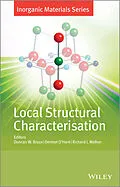Inorganic materials are at the heart of many contemporary
real-world applications, in electronic devices, drug delivery,
bio-inspired materials and energy storage and transport. In order
to underpin novel synthesis strategies both to facilitate these
applications and to encourage new ones, a thorough review of
current and emerging techniques for materials characterisation is
needed.
Examining important techniques that allow investigation of the
structures of inorganic materials on the local atomic scale,
Local Structural Characterisation discusses:
* Solid-State NMR Spectroscopy
* X-Ray Absorption and Emission Spectroscopy
* Neutrons and Neutron Spectroscopy
* EPR Spectroscopy of Inorganic Materials
* Analysis of Functional Materials by X-Ray Photoelectron
Spectroscopy
This addition to the Inorganic Materials Series provides a
detailed and thorough review of these spectroscopic techniques and
emphasises the interplay between chemical synthesis and physical
characterisation.
Autorentext
Series Editors
Duncan W. Bruce, Department of Chemistry, University of York, UK
Dermot O'Hare, Chemistry Research Laboratory, University of Oxford, UK
Richard I. Walton, Department of Chemistry, University of Warwick, UK
Klappentext
Inorganic materials are at the heart of many contemporary real-world applications, in electronic devices, drug delivery, bio-inspired materials and energy storage and transport. In order to underpin novel synthesis strategies both to facilitate these applications and to encourage new ones, a thorough review of current and emerging techniques for materials characterisation is needed.
Examining important techniques that allow investigation of the structures of inorganic materials on the local atomic scale, Local Structural Characterisation discusses:
- Solid-State NMR Spectroscopy
- X-Ray Absorption and Emission Spectroscopy
- Neutrons and Neutron Spectroscopy
- EPR Spectroscopy of Inorganic Materials
- Analysis of Functional Materials by X-Ray Photoelectron Spectroscopy
This addition to the Inorganic Materials Series provides a detailed and thorough review of these spectroscopic techniques and emphasises the interplay between chemical synthesis and physical characterisation.
Inhalt
Inorganic Materials Series Preface xi
Preface xiii
List of Contributors xv
1 Solid-state Nuclear Magnetic Resonance Spectroscopy 1
Sharon Ashbrook, Daniel Dawson and John Griffin
1.1 Overview 1
1.2 Theoretical Background 3
1.2.1 Fundamentals of NMR 3
1.2.2 Acquisition of Basic NMR Spectra 4
1.2.3 Relaxation 7
1.2.4 Interactions in NMR Spectroscopy 7
1.3 Basic Experimental Methods 15
1.3.1 Spin I = 1/2 Nuclei 15
1.3.2 Spin I > 1/2 Nuclei 24
1.3.3 Wideline NMR Spectroscopy 30
1.4 Calculation of NMR Parameters 31
1.4.1 Introduction to Density Functional Theory 31
1.4.2 Basis Sets and Periodicity 32
1.4.3 Reducing the Computational Cost of Calculations 33
1.4.4 Application of First-principles Calculations 34
1.5 Applications of Solid-state NMR Spectroscopy 36
1.5.1 Local and Long-range Structure 36
1.5.2 Measuring Internuclear Interactions 43
1.5.3 Disordered Materials 46
1.5.4 Studying Dynamics 50
1.5.5 Challenging Nuclei and Systems 54
1.5.6 Paramagnetic Materials and Metals 56
1.6 Commonly Studied Nuclei 59
1.6.1 Hydrogen 59
1.6.2 Lithium 61
1.6.3 Boron 62
1.6.4 Carbon 62
1.6.5 Oxygen 62
1.6.6 Fluorine 63
1.6.7 Sodium 63
1.6.8 Aluminium 64
1.6.9 Silicon 64
1.6.10 Phosphorus 64
1.6.11 Xenon 65
1.7 NMR of Materials 65
1.7.1 Simple Ionic Compounds and Ceramics 65
1.7.2 Microporous Materials 67
1.7.3 Minerals and Clays 74
1.7.4 Energy Materials 76
1.7.5 Glasses 78
1.7.6 Polymers 81
1.8 Conclusion 83
References 84
2 X-ray Absorption and Emission Spectroscopy 89
Pieter Glatzel and Amelie Juhin
2.1 Introduction: What is Photon Spectroscopy? 89
2.2 Electronic Structure and Spectroscopy 93
2.2.1 Total Energy Diagram 93
2.2.2 Interaction of X-rays with Matter 96
2.3 Calculation of Inner-shell Spectra 106
2.3.1 The Single-particle Extended Picture of Electronic States 107
2.3.2 The Many-body Atomic Picture of Electronic States 109
2.3.3 Comparison of Theoretical Approaches 112
2.3.4 The Many-body Extended Picture of Electronic States 113
2.3.5 Single-particle Calculation of the Absorption Cross-section 114
2.3.6 Many-body Atomic Calculation of the Cross-section 118
2.3.7 Which Approach Works Best for Inner-shell Spectroscopy? 118
2.3.8 Beyond Standard DFT Methods 119
2.4 Experimental Techniques 120
2.4.1 X-ray Absorption Spectroscopy 121
2.4.2 X-ray Raman Spectroscopy 130
2.4.3 Nonresonant X-ray Emission (X-ray Fluorescence) 131
2.4.4 Resonant Inelastic X-ray Scattering 137
2.5 Experimental Considerations 155
2.5.1 Modern Sources of X-rays 155
2.5.2 Ultrafast X-ray Spectroscopy 157
2.5.3 Measuring XAS/XES 158
2.6 Conclusion 163
Acknowledgement 164
References 164
3 Neutrons and Neutron Spectroscopy 173
A. J. Ramirez-Cuesta and Philip C. H. Mitchell
3.1 The Neutron and How it is Scattered 174
3.1.1 The Scattering Law 175
3.2 Why Neurons? 179
3.2.1 The S(Q,w) Map 180
3.2.2 Modelling of INS Spectra 181
3.2.3 Example of the Effects of Sampling of the Brillouin Zone 183
3.2.4 INS Spectrometers 184
3.2.5 Measurement Temperature 189
3.2.6 Amount of Sample Required 189
3.3 Molecular Hydrogen (Dihydrogen) in Porous Materials 190
3.3.1 The Rotational Spectrum of Dihydrogen 190
3.3.2 The Polarising Power of Cations and H2 Binding 191
<...